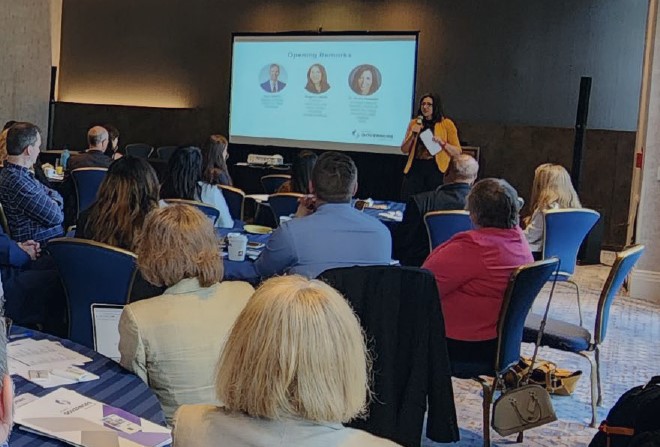This paper includes considerations and approaches to promote equity and improve public health capacity to prevent, detect and respond to HIV, viral hepatitis, STDs and TB during the public health emergency and beyond.
(Download)
Access to adequate screening and efficient linkage to treatment for HIV, viral hepatitis, sexually transmitted diseases (STDs) and tuberculosis (TB) suffered during the first year of the COVID-19 pandemic. Physical distancing policies, the temporary delay of elective in-person care and patients’ fear of COVID-19 infection contributed to barriers for patients seeking services, harming the progress made in reducing incidence and prevalence of these diseases. For example, HIV screening, diagnoses and viral load tests decreased between March and September 2020. Similarly, hepatitis C antibody testing volume fell 59 percent during April 2020, with only a six percent baseline increase by July that same year. Prior to the COVID-19 pandemic, HIV treatment and prevention services were improving, creating an opportunity for the United States to potentially reduce new cases to fewer than 3,000 per year by 2030. Achieving this and other infectious disease goals stalled as program resources and personnel were redirected from HIV, viral hepatitis, STDs and TB to manage the COVID-19 public health emergency. According to a survey from the National Viral Hepatitis Roundtable, local health departments reduced services like provider outreach and education, hepatitis A and hepatitis B vaccinations, case investigation and surveillance, outbreak response and harm reduction programs due to the pandemic.
The additional barriers created by the COVID-19 could lead to increases in HIV, viral hepatitis, STDs and TB rates in underserved communities. Groups such as racial and ethnic minorities, people who use drugs, incarcerated persons, houseless persons and members of the LGBTQ+ community are disproportionately impacted by these diseases. According to a Kaiser Family Foundation survey of Ryan White grantees, safety-net providers have tried various strategies to keep patients engaged, including telehealth, self-testing, testing for COVID-19 and HIV during the same visit and writing multi-month prescriptions. The Centers for Disease Control and Prevention (CDC) also funded innovative strategies like HIV self-testing and training nurses to fill gaps in provider capacity to offer HIV pre-exposure prophylaxis (HIV PrEP) through state and local health departments. These and other strategies have not only been crucial during the public health emergency, but they are also creating promising pathways for improved, equitable care for these diseases.
Considerations for Governors
Governors have led the charge during the COVID-19 pandemic, establishing a renewed commitment to strong public health policies and infrastructure through a whole of society approach to tackling challenging issues, including supporting strategies to prevent and treat HIV, viral hepatitis, STDs and TB. This response requires collaboration with a broad range of stakeholders to ensure strategies engage and support populations living with or at risk of these diseases. The National Governors Association Center for Best Practices (NGA Center) conducted interviews, reviewed research and hosted an expert roundtable to review and share information on best and promising practices. The NGA Center developed the following considerations and approaches Governors might implement to promote equity and improve public health capacity to prevent, detect and respond to HIV, viral hepatitis, STDs and TB. The strategies fell into the following thematic areas:
- Supporting and sustaining community-based, public-private and/or fiscal partnerships with departments of health to achieve testing and treatment goals.
- Expanding care outside of the clinical setting and reduce barriers that may exacerbate disparities in testing and treatment by implementing innovative approaches such as virtual, mobile and home care.
- Recruiting, training and sustaining a public health workforce to facilitate and provide education, counsel, test and treat in both clinical and non-clinical settings.
CONSIDERATION ONE: Support and sustain community-based, public-private and/or fiscal partnerships with departments of health to achieve testing and treatment goals.
The COVID-19 pandemic underscored the Governor’s role as the convenor; Governors build the table for stakeholders to pull up a chair, examine issues and develop solutions. The group of stakeholders involved in addressing HIV, viral hepatitis, STDs and TB is diverse, making partnerships between these groups critical to coordinate resources, develop creative solutions, alleviate barriers and explore pathways to build sustainable, positive change. Governors may bring stakeholders to the table that include but are not limited to those in Figure 1.
FIGURE 1. HIV/AIDS, Viral Hepatitis, STDs and TB Stakeholders
- State agencies and departments, e.g.,
- – Medicaid program
– Insurance departments
– Equity offices
– Maternal and child health/Title V
– Department of health
– Department or division of infectious diseases/ HIV programs
– Department of labor
– Department or division of behavioral health
– Department of corrections
– Housing authorities or departments
– Education departments
– Public safety departments
– Transportation departments
– Human services departments
- Providers, e.g., Ryan White providers, community health centers, health systems within the state
- LGBTQ+ commissions and/or advocacy organizations
- Title X grantees
- State legislators
- Professional associations and workforce boards, e.g., physicians and pharmacists
- Business leaders
- State immunization action coalitions
- Major advocacy groups within the state, e.g., state chapter of Human Rights Campaign
- Community-based organizations serving groups affected by HIV/AIDs, viral hepatitis, STDs and TB
- People living with HIV/AIDs, viral hepatitis, STDs and TB
STRATEGIES AT WORK
Washington – In December 2014, Governor Jay Inslee issued a proclamation creating End AIDS Washington with the goal of reducing statewide HIV incidence by 50 percent in five years. Governor Inslee used End AIDS Washington to identify barriers and key stakeholders that could enact change to remove barriers and achieve goals including persons living with HIV, local school districts, the affordable housing sector, the Office of the Superintendent of Public Instruction and others outlined in Figure 1. The urgency to “act now” to End AIDS in Washington” was driven by community members and organizations and the Governor tasked the existing integrated HIV care and prevention Steering Group to craft the plan and recommendations. This group recommended a set of five goals focused on reducing stigma, mortality rates, and health disparities while improving quality of life for those living with HIV. Through this initiative, state agencies and external groups established strong relationships, leading to progress beyond HIV/AIDS, including aligning with the Dr. Robert Bree Collaborative, which built on the End AIDS Washington work to develop the LGBTQ Health Care Report and Recommendations. Similarly, Washington led the nation in elimination efforts at the direction of Governor Inslee by unveiling the first-in-nation approach to eliminating hepatitis C. The Department of Health will release an End AIDS Washington final report as the five-year period ended in 2020 and although the initiative was disrupted by COVID-19, they plan to leverage progress made into a new Ending the Epidemics effort. This new program includes a focus on HIV as well as hepatitis B and C and Congenital Syphilis.
Oregon – On World AIDS Day, 2016, Oregon launched its End HIV Oregon campaign, supported by the HIV/Viral Hepatitis/Sexually Transmitted Infection Planning Group (IPG), a statewide planning group that includes the representative constituents identified in Figure 1. Each year, on December 1, the Oregon Health Authority reports on progress towards its End HIV Oregon goals of increasing HIV testing, prevention, and treatment, and eliminating health disparities. Successes have included statewide implementation of HIV Early Intervention Services and STD-related HIV prevention, and expansion of key services such as HIV self-testing, HIV PrEP, supportive housing for people living with HIV and culturally specific services for Latinos.
GOVERNORS MAY CONSIDER THE FOLLOWING ACTIONS TO SUPPORT CROSS-AGENCY COLLABORATION:
- Create, support and maintain multi-sectoral cross-agency working groups to evaluate capacity and coordinate funding and efforts across agencies and among stakeholders.
- Encourage creative partnerships such as a network of HIV and STI providers in the state to share data and promising practices.
- Consider opportunities to partner with industry or health system stakeholders on initiatives such as self-testing.
- Coordinate data-sharing across platforms and agency data systems to better identify outbreaks and ensure continuity of care for patients and providers.
- Work with providers and community partners to identify and address barriers to treatment.
- Explore regulatory and/or legislative actions to increase access to care.
CONSIDERATION TWO: Expand care outside of the clinical setting and reduce barriers that may exacerbate disparities in testing and treatment by implementing innovative approaches such as virtual, mobile, and home care.
In response to the disruption of screening and treatment services for HIV, viral hepatitis, STDs and TB caused by the COVID-19 pandemic, state officials and providers employed creative methods of reaching people outside clinical settings. Providers, including community-based health organizations, established programs for self-testing, mobile health care and telehealth. These strategies were crucial during the COVID-19 pandemic shift in care to meet individuals where they are, allowing options for privacy and integrating prevention and treatment into everyday care. The strategies below are not only creative methods of delivery, but crucial strategies for allowing people to receive services from trusted providers.
Telehealth and Telemedicine
The COVID-19 pandemic brought significant flexibility for telehealth, providing the opportunity for states to invest in evidence-based virtual services for HIV/STD testing, treatment, and prevention. Telehealth removes barriers to care by reducing travel, time off work and offering a more private option for individuals concerned about going to a clinic. Flexibilities offered through the public health emergency such as reimbursement, coverage, patient location and provider eligibility for practicing telehealth greatly expanded access. For a detailed look into state flexibilities that could potentially remain permanent, see NGA’s recently published paper, The Future of State Telehealth Policy.
Telehealth was an option before the COVID-19 pandemic, though services were limited. The COVID-19 pandemic prompted broad flexibility across payers and health systems. Depending on the service and treatment plan, telehealth can be used in a variety of ways, ranging from a one-time appointment for a prescription to ongoing care for ordering tests, providing HIV PrEP prescriptions, managing viral load and connecting patients with specialty care. Telehealth also offers an option for maintaining continuity of care for individuals requiring consistent care, such as those managing an HIV diagnosis.
STRATEGIES AT WORK
Georgia – Created prior to the pandemic, the Georgia Telehealth Network enabled state officials to offer significantly more virtual services. The network is run by the Georgia Department of Public Health Office of Telehealth & Telemedicine and provides a wide range of services, including HIV and STD care. The telehealth network also offers case management and care coordination, ensuring individuals remain connected to providers even without office visits. Additionally, the network links county health officials and specialty clinics to expand care across the state while offering a hybrid model of onsite and virtual care. The hybrid approach helps the network reach rural and underserved areas where patients may not have broadband in their homes.
Self-Testing
Although offered before the COVID-19 pandemic, self-testing and/or self-sample collection services for HIV and some STDs were expanded through partnerships and grants with private entities, community-based organizations and through the federal government. During the first year of the pandemic, self-testing was essential for people with HIV who were at increased risk of COVID-19. A summary of self-testing programs developed since 2019 found them to be effective in the goal of making tests more accessible as well as an efficient way to deliver care. In addition to the HIV/STD tests themselves, self-testing is a key opportunity to integrate educational materials and referrals to other services if needed. For example, the Nebraska Department of Health and Human Services HIV Self-Testing Program includes risk reduction literature and condoms in their test kits. For individuals who test positive, the program follows up by linking them to their local health department and the Nebraska AIDS Project, setting up clinic appointments and informing patients of available financial assistance. Self-testing programs can also be key in connecting individuals with prevention measures. HIV PrEP referrals require a negative HIV test and work best with testing every three months, both made easier through self-testing, especially in areas with high COVID-19 community spread.
Funding for at-home testing program varies by state, though it often includes grants, state contracts, public-private partnerships or federal funds. Roundtable participants and other experts highlighted the importance of flexibility in the grantmaking process. While some entities such as departments of health and hospital systems can implement large grants, other entities such as community-based organizations may not have the same capacity. Nevertheless, smaller organizations are well-positioned to help, and many could implement smaller grants or “per-test” grants in which they can bill the state for every test rather than handling larger sums of funds. Self-testing programs operate differently based on state and community capacity. In some circumstances, state departments of health have the capacity to run the program on their own, while other states have had success contracting the work out to community-based organizations with more capacity and ties to the community.
STRATEGIES AT WORK
Virginia – The Virginia Department of Health runs the state’s self-testing initiative for HIV. To get the tests, individuals apply through a survey to determine their eligibility. Testing kits are then shipped directly from the department to the individual. In addition to the tests themselves, shipments include information on community-based services in the area, HIV PrEP pamphlets and referrals in the event of a positive test.
Arizona – The Arizona Department of Health Services, through their HIV Prevention Program, has a partnership with a community-based organization, Aunt Rita’s to run the state’s self-testing initiative. In addition to self-testing, the organization incorporates other services, including referrals for HIV prevention and treatment, advocacy and awareness to reduce stigma around HIV and aging support for older adults living with HIV. By contracting out self-testing to a trusted community provider, Arizona officials were able maintain capacity during COVID-19 response and recovery while leveraging the expertise of community providers.
Mobile Health
While bringing care into the community through mobile vans, pop-up clinics or community events is not a new idea, the COVID-19 pandemic prompted interest in expanding these programs to maintain community options moving forward. Mobile clinics are typically run by community leaders and have the flexibility to target hard-to-reach populations such as racial minorities and people with limited English proficiency. An analysis of clinics participating in the Mobile Health Map found 59 percent of people served by mobile clinics are racial/ethnic minorities and 38 percent were experiencing homelessness, highlighting progress toward reaching populations faced with barriers to in-clinic care.
Like other community initiatives, there is a wide range of funding options for mobile clinics, including federal funds, state funding, smaller targeted grants and Medicaid reimbursement. Mobile health clinics are funded by philanthropies, compared with an estimated 27 percent funded through state budgets.
States have also creatively leveraged federal funding to support mobile health clinics. For example, the Colorado Department of Human Services used an opioid response grant to fund six mobile health units that specialize in medications for opioid use disorder as well as syringe disposal at some locations. Although the mobile unit did not explicitly target those with HIV, viral hepatitis, STDs and TB, states can use funding to target these diseases specifically by offering a “one stop shop” for multiple infectious disease testing, referrals to wraparound services, syringe services programs and other harm reduction strategies.
Although mobile options provide flexibility, some states have licensing regulations that go beyond federal requirements for receiving Medicare and Medicaid reimbursement for in-clinic services. For example, some states require mobile clinics to be run by a physician or medical professionals with doctoral degrees in laboratory science. States can ease barriers by creating specific regulations for mobile clinics that do not go beyond federal requirements. California, for example, passed legislation clarifying regulations for mobile health clinics by ensuring adherence to only minimum requirements for Medicare reimbursement for in-clinic services.
GOVERNORS MAY CONSIDER THE FOLLOWING ACTIONS TO SUPPORT INITIATIVES BRINGING CARE INTO COMMUNITIES:
- Examine options for policy flexibilities that may make providing services via telehealth, mobile care and at-home care easier.
- Coordinate federal, state and local funding for mobile health centers to allow expansion of mobile clinics.
- Allow flexibility in funding options ranging from small one-time grants to ongoing funding for community- based programs.
- Integrate anti-stigma, referral and educational materials into community-based delivery models.
CONSIDERATION 3: Recruit, train and sustain a public health workforce to facilitate and provide education, counsel, test and treat in both clinical and non-clinical settings.
In addition to exacerbating longstanding gaps in the public health workforce, the COVID-19 pandemic resulted in many public health workers burning out and leaving the sector. State officials and public health workers specializing in infectious disease were particularly hard hit as they were typically the first people to be redeployed to the pandemic response. The COIVD-19 pandemic highlighted the importance of allied health professionals such as community health workers, peer coordinators and patient navigators, who helped disseminate information about public health measures and coordinate care. Research suggests that employing public health workers is a cost-effective strategy for coordinating care and retaining individuals in need of ongoing prevention and treatment services. In response to the strain that the pandemic put on the workforce, Congress and the Biden Administration approved 7.4 billion dollars for the public health workforce. The funding incorporates a variety for initiatives, including but not limited to recruiting and training public health leaders, grants for permanently employing community health workers and addressing the understaffing of public health departments.
“Public health worker” is a broad term which includes non-physician workers who provide support services and care coordination. For the management of HIV and
other STDs, the professionals are often members of their community who help coordinate care across different specialties. The public health workers who are the focus of this publication include community health workers, peer support specialists, case managers and other professionals who help coordinate ongoing care.
Health Homes
By exploring alternative methods of delivering and paying for care, states can creatively leverage different types of public health professionals as part of a care and coordination team. States are experimenting with alternative payment methods, giving them the opportunity to use payment to incentivize the use of public health workers to help coordinate care.
Health homes are required to offer:
- Comprehensive care management;
- Care coordination;
- Health promotion;
- Comprehensive transitional care;
- Individual and family support services; and,
- Referral to community or social support services.
The New York Health Homes Plus program for people living with HIV/AIDS demonstrates how professionals such as peer navigators, care coordinators and community health workers can be integrated into existing efforts to more efficiently reimburse services. In addition to certification and licensure requirements, New York identified competencies that case managers, peer coordinators and community health workers must have, such as harm reduction, LGBTQ+ health and co-occurring disorders.
There are opportunities to coordinate efforts with existing initiatives through the Governor’s office, workforce boards or departments of labor. Promoting opportunities to continue building skills as they move through the public health sector is just one way states can retain this portion of the workforce. For example, during the public health emergency, workers were expeditiously trained as contact tracers, peer coordinators and medical reserve volunteers. This represents a trained, experienced population that could be retained and redeployed to other public health emergencies or traditional public health roles. States could also promote continuing education in prevention and treatment of HIV, viral hepatitis, STDs and TB to support a career path in public health for everyone from entry-level allied health professionals to licensed primary care providers.
STRATEGIES AT WORK
Washington – The Washington Health Workforce Council sits within the state’s Workforce Training & Education Coordinating Board. The Council’s key function is to identify capacity and funding priorities for the public health workforce. In response to workforce shortages, stakeholders have suggested training programs such as apprenticeships and grants for educational institutions to provide additional training and certification. Recently, the Council released a report detailing strategies to address public health workforce shortages resulting from COVID-19. Further, the Council recommended developing career pathways so entry-level health care workers can receive more training and ultimately be retained in the sector, demonstrating that existing infrastructures can be leveraged to sustainably fund targeted initiatives.
As federal and state governments direct resources to training and retention of public health professionals, Governors may consider sustainable sources of funding and reimbursement. There is no single solution for providing coverage and reimbursement for allied health workers, though states have significant flexibility to cover coordination and counseling services rendered by these providers. Doing so can create a more sustainable pipeline of workers that is less dependent on private or philanthropic funding. One source states can leverage to prevent STDs is CDC Disease Intervention Specialists (DIS) Workforce Development Funding. Part of the American Rescue Plan Act of 2021, the funding is earmarked to be used over a five- year period for state, local and territorial jurisdictions to hire, expand, train, sustain and support DIS to strengthen the capacity public health departments and mitigate the spread of COVID-19 and other infectious diseases.
Examples of Strategies for Reimbursing Public Health Professionals
| State | Policy Lever | Description | Advantages/Disadvantages |
|---|---|---|---|
| New Hampshire | Medicaid 1115 Waiver | New Hampshire modified their Delivery System Reform Incentive Payment (DSRIP) to allow providers to form Integrated Delivery Networks that include a range of providers including peer-based support or community health workers. | Target specific populations and can ask for additional federal funding for the program. |
| Minnesota | State Plan Amendment | Minnesota updated their Medicaid state plan so community health workers could bill for care coordination and patient education services. | Advantage: Administratively much easier to get Disadvantage: Must be statewide |
| Massachusetts | Legislation | Massachusetts passed legislation establishing that Accountable Care Organizations may reimburse community health workers as part of a larger care team. | Codified—harder to change once it is there |
| Michigan | Coverage requirement in Managed Care | Michigan requires Managed Care Organizations (MCOs) the state Medicaid agency contracts with to arrange availability of community health workers or peer support specialists to enrollees with behavioral health needs and/or physical co-morbidities. | Don’t need federal approval to do things in managed care contracts—only strategy that works in states where there is significant MCO penetration. Not a good option in rural states/lower population states. |
GOVERNORS MAY CONSIDER THE FOLLOWING ACTIONS TO SUPPORT A SUSTAINABLE PUBLIC HEALTH WORKFORCE:
- Collaborate with state workforce and labor boards to identify opportunities for training and/or certification of allied health professionals.
- Identify sustainable career pathways for public health workers who want to receive more skills and training.
- Examine options for Medicaid coverage for public health workers to be reimbursed individually or as part of a care team.
- Utilize existing resources for public health workers to receive additional training and expertise.
Conclusion
Though the COVID-19 pandemic highlighted serious barriers to providing and receiving prevention, testing and treatment services, there are clear opportunities to strengthen capacity moving forward. The strategies highlighted in this paper were promising practices before the pandemic, but renewed attention to community-based care and collaboration has presented an opportunity to institutionalize strategies that were successful during the COVID-19 pandemic. These strategies have the potential to increase access to care, particularly for populations who still feel stigmatized in clinical settings.
Acknowledgements
The National Governors Association Center for Best Practices (NGA Center) would like to thank the state officials and other experts who offered insights that informed this publication. A special thank you goes to the participants in the NGA Center expert roundtable on Building State Capacity for Prevention, Testing and Treatment of HIV, STDs, viral hepatitis and TB.
The NGA Center would also like to thank the Centers for Disease Control and Prevention (CDC) for their generous support of the expert roundtable and this publication under cooperative agreement.
The contents of this publication are solely the responsibility of the authors and do not necessarily represent the official views of the CDC or the US Department of Health and Human Services.
This publication was developed by policy analysts Kelsey Ruane, Michelle LeBlanc, Senior Policy Analyst Caroline Picher, Program Coordinator Mollie Fairbanks and Program Director Brittney Roy at the NGA Center for Best Practices.
Recommended Citation
Ruane, K., LeBlanc, M., Picher, C., Fairbanks, M., and Roy, B., (August 2021). State Strategies to Build Capacity for Prevention, Testing, and Treatment of HIV, STDs, Viral Hepatitis, and TB. Washington, DC: National Governors Association Center for Best Practices.*
*Kelsey Ruane, Caroline Picher and Molly Fairbanks contributed to the development of this report during their tenure at the NGA Center.













